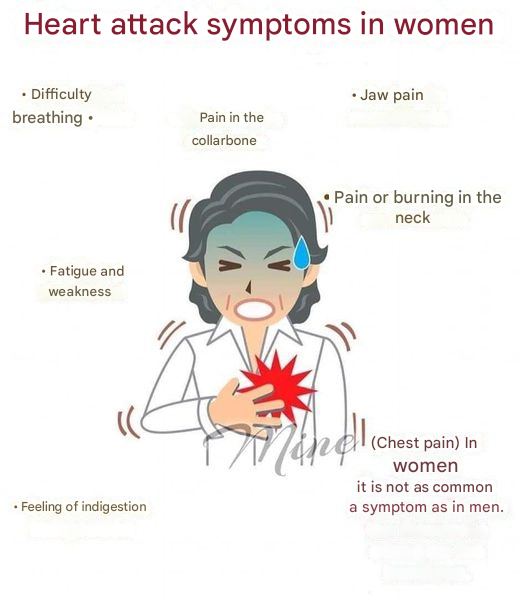ADVERTISEMENT
The heart is the cornerstone of our health. It works tirelessly every second to pump blood throughout our body, delivering oxygen and nutrients to the organs and tissues that need them. When the heart is diseased, it can lead to severe complications, including heart attacks, heart failure, and even death. Identifying the symptoms of heart disease early can significantly improve outcomes, as timely intervention can prevent the condition from worsening.
Heart disease often doesn’t present dramatic symptoms at first, which is why it’s important to recognize the warning signs. Here’s a detailed look at the dangerous symptoms that may indicate a diseased heart and what to do if you experience them.
1. Chest Pain (Angina)
Chest pain is one of the most common and serious symptoms of heart disease. It can range from mild discomfort to severe pain, and it may be felt as a tightness, pressure, or aching sensation in the chest. This pain can occur when the heart is not receiving enough oxygen-rich blood, a condition known as angina.
Dangerous sign: Angina that occurs at rest or lasts for more than a few minutes is a medical emergency and may indicate a heart attack.
2. Shortness of Breath
Feeling short of breath, especially when engaging in physical activity or even while resting, is a major symptom of heart disease. The heart’s inability to pump blood effectively can lead to fluid buildup in the lungs, causing difficulty breathing. This is particularly common in conditions like heart failure or coronary artery disease.
Dangerous sign: If shortness of breath occurs suddenly and is accompanied by chest pain or discomfort, it could be a sign of a heart attack. Seek immediate medical attention.
3. Fatigue and Weakness
Extreme fatigue, even with minimal exertion, is often a warning sign of heart disease. When the heart isn’t functioning properly, your body may not get enough oxygen or nutrients, leading to feelings of exhaustion. This can also be associated with heart failure, where the heart’s pumping power is weakened.
Dangerous sign: Sudden or unexplained fatigue that doesn’t improve with rest could indicate that your heart is struggling to maintain proper circulation.
4. Swelling in the Legs, Ankles, or Feet
Swelling, or edema, in the lower extremities can occur when the heart is unable to pump blood effectively. This leads to fluid retention in the body, and it is especially noticeable in the legs, ankles, and feet. In severe cases, swelling can extend to the abdomen.
Dangerous sign: If swelling is accompanied by difficulty breathing, it may be a sign of heart failure or a serious cardiovascular issue. Seek medical help immediately.
5. Irregular Heartbeat (Arrhythmia)
An irregular or abnormal heartbeat, also known as arrhythmia, can cause palpitations, dizziness, or fainting. The heart may beat too quickly, too slowly, or in an uncoordinated rhythm. Some arrhythmias can be harmless, but others can be life-threatening if left untreated.
Dangerous sign: If you experience sudden, severe palpitations, or if your heartbeat feels very irregular or erratic, it could indicate a serious issue, such as atrial fibrillation or ventricular arrhythmia, both of which can lead to stroke or heart attack.
6. Dizziness or Lightheadedness
Feeling dizzy, lightheaded, or fainting can occur when the heart isn’t pumping blood efficiently, which reduces oxygen levels in the brain. This can happen if you have arrhythmia or heart failure. Sometimes dizziness can also be linked to low blood pressure, which may result from a weakened heart.
Dangerous sign: If dizziness is accompanied by chest pain, shortness of breath, or fainting, it could indicate that your heart is not functioning properly and requires immediate medical attention.
7. Pain or Discomfort in Other Areas of the Body
While chest pain is the most common symptom of heart disease, pain can also be referred to other parts of the body, including the arms, shoulders, neck, back, jaw, or stomach. This is particularly true during a heart attack, where discomfort may radiate away from the chest.
Dangerous sign: If you experience unexplained pain or discomfort in these areas, especially if it’s combined with other symptoms like shortness of breath, nausea, or sweating, it could be a sign of a heart attack. Don’t ignore these warning signals.
8. Cold Sweat or Sweating Profusely
Breaking out in a cold sweat without any obvious reason, such as physical exertion, can be a serious sign of a heart attack. Many people describe sweating during a heart attack as being similar to the feeling of a cold, clammy sweat.
Dangerous sign: If excessive sweating occurs with other symptoms, such as chest pain or shortness of breath, it’s important to seek immediate medical care.
9. Nausea or Indigestion
Heart disease can cause digestive issues such as nausea, indigestion, or vomiting, especially during a heart attack. Women, in particular, may experience these symptoms more frequently than men. The discomfort might feel like an upset stomach, but it can also be a sign that your heart is in trouble.
Dangerous sign: If you feel nauseous, especially if it’s accompanied by pain or discomfort in the chest, jaw, or arms, don’t dismiss it. It may be a sign of an impending heart attack.
10. Coughing or Wheezing
A persistent cough or wheezing can be a sign that your heart is failing. When the heart can’t pump blood effectively, it can cause fluid to build up in the lungs, leading to coughing, wheezing, or a feeling of tightness in the chest.
Dangerous sign: A chronic cough or wheezing, especially if it produces pink or blood-tinged mucus, could indicate heart failure, and you should seek medical attention right away.
continued on next page
ADVERTISEMENT
